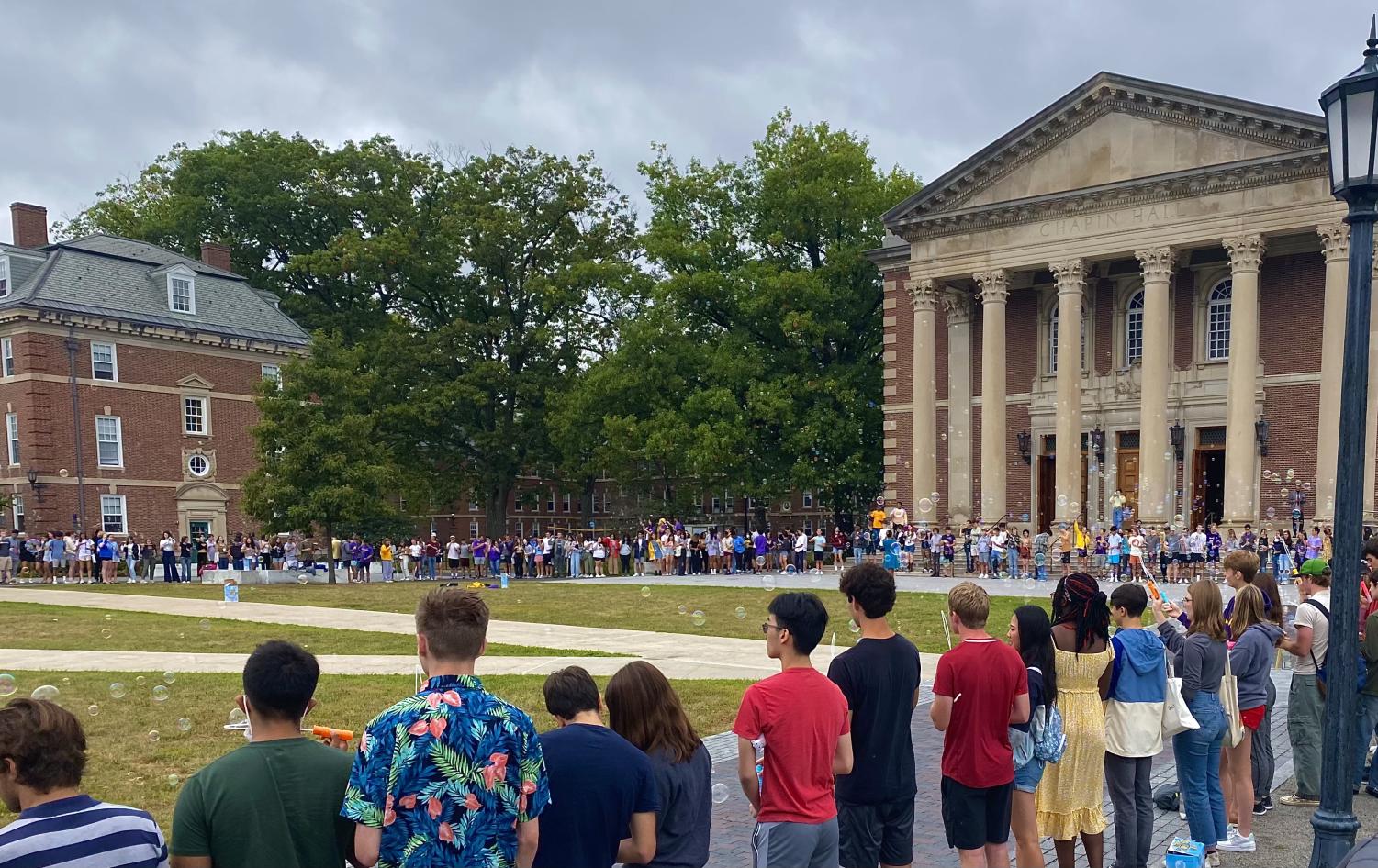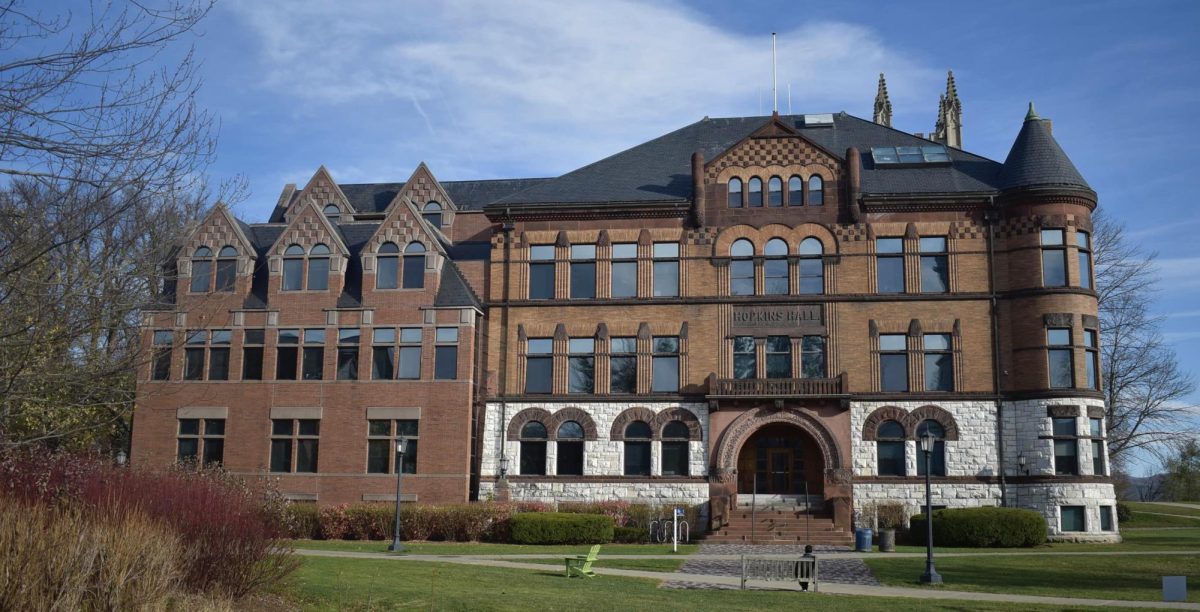Class of 2026 makes history as largest first-year class
September 28, 2022

The target size for an incoming class is 550 students, according to Dean of Admissions Liz Creighton ’01 — but the Class of 2026 is currently composed of 577 students, making it the largest first-year class in the College’s history. This increase in first-year students has inevitably affected many aspects of student life, including the entry system, dorm allocation, and EphVentures.
While the Class of 2025 was nearly identical in size, with 574 students, 103 of those students had originally been accepted to the Class of 2024 and decided to take a gap year — a change that Creighton attributed largely to the COVID-19 pandemic. The Class of 2026, on the other hand, is large for seemingly different reasons.
A number of factors could have contributed to more students than usual committing to the College this year, though many cited the College’s new all-grant financial aid policy as one strong selling point for prospective students.
“Enrollment shifts are always the result of both internal and external factors,” Creighton wrote in an email to the Record. “Certainly, the announcement of the College’s all-grant financial aid program likely had some impact on the size of this class, but so too did dynamics at other colleges and universities to which students admitted to Williams also applied.”
Serah Park ’26 said the all-grant financial aid program was a significant factor in why her friends chose to attend the College. “I know that a lot of my friends committed to Williams because Williams would provide them the best financial aid, especially after the whole all-grant program,” she said.
Muhammad Haad ’26, an international student from Pakistan, added that while many prominent colleges in the United States scaled down funding for internationals in the post-COVID era, Williams remained generous. “It basically boiled down to which college gave me the most aid,” he said.
The unexpectedly high number of first-years has also affected the Junior Advisor (JA) program and first-year entry system, which have been shifted to accommodate the large class. For example, there are fewer JAs per entry than in past years.
“[The JAs] originally wanted to have four-person co-groups, and then we only got three-person co-groups,” JA to the Class of 2026 Leo Marburg ’24 said. “I don’t know how much of that is [because] we didn’t have enough JAs, but [also] there are just so many first-years that we had to be spread out.”
Marburg said that he had two JAs for his first-year entry two years ago, as a handful of JAs decided to take time off or stepped down after the onset of the pandemic, but he stressed that the entries in his first year were smaller in size due to the fact that students did not have roommates because of COVID health policies.
Marburg, who currently has two co-JAs for the 34 first-years in Sage 1, also said that JAs have adapted well to the new system. “I know it wasn’t what they planned, and part of that had to do with the bigger class size,” he said. “But I think it’s a good number. I think it’s all working out.”
Not only are fewer JAs managing entries, but the unexpectedly large Class of 2026 also prompted a last-minute reevaluation of which buildings the College would choose to accommodate first-years.
“By the time we became aware of the larger incoming class in early/mid May, we’d already assigned a number of students through the Housing Accommodations process into several buildings around campus,” Senior Associate Dean of Campus Life Doug Schiazza wrote in an email to the Record. “To redo that process would have required significant effort and time … and we didn’t want to make those pre-assigned students have to adjust their expectations again if we could help it.”
Schiazza and his colleagues struggled to find a dorm that could house a large number of first-years while being conducive to community-building. Complicating matters further, the College’s new laser-scanned floor plans revealed that many rooms that had been used as doubles in Williams and Sage Halls had to be converted to singles due to minimum square footage requirements. Tyler Annex — often referred to by students as “Tannex” — emerged as the most promising candidate.
For Park, who lives in a Tyler Annex “dingle” (a double room with one occupant), her room assignment came as a surprise. “I actually didn’t look much into Tannex before receiving the housing assignments because I didn’t expect myself to be placed in here,” Park said. “Most people I know in Tannex ranked Tannex last, actually, and those that ranked it not-last didn’t really know much about it and just put it down randomly.”
While Park spoke warmly of her JAs and entrymates, she acknowledged that their housing situation has made entry bonding more difficult than usual. “The Tannex entry is pretty big,” Park continued. “We have 51 frosh with five JAs, which is a lot… Right now I don’t feel too close to my Tannex entrymates because a lot of us are usually just in Tannex to sleep. We just always hang out in Mission or Frosh Quad.”
The large class size also presented some problems when it came to First Days and EphVentures. Williams Outdoor Orientation for Living as First-Years (WOOLF), an overnight backpacking orientation program, strictly limits the number of people in each group to eight — not enough to accommodate the larger class. Because WOOLF leaders were selected in January, long before all 577 students had committed to the College, there were not enough leaders to increase the number of groups.
Additionally, 17 first-years were not assigned to any EphVenture, but instead took part in a makeshift program called “What Am I Doing?” led by three upperclass students.
“At WOOLF, we were at capacity for the most part,” WOOLF co-Director Will McCormick ’23 explained. “It was a difficult challenge — how are we able to help these freshmen but also maintain WOOLF and not overrun ourselves?”
McCormick said that last year’s addition of the WOOLF BASE CAMPus program, in which students sleep in their dorms at night and go hiking during the day, was helpful in accommodating more students, since there can be 10 first-years per BASE CAMPus group.
Despite challenges along the way, Marburg reflected on the upsides of a larger class. “When you have a bigger class, you have more people that can participate in clubs, and so that’s going to benefit student life,” he said.
Marburg also said he would prefer that the College embrace more students instead of making admissions even more selective. “Rather than cutting down admissions even further and having fewer people come, I think that it’s nicer to have a bigger class,” he said. “And maybe Williams, with all the money that it has, could build more housing.”
Creighton said she has already been enjoying working with the Class of 2026, even if there are a few more students than usual. “They’re an incredible group, and it’s been a joy to get to know them during their first few weeks on campus,” she said.







